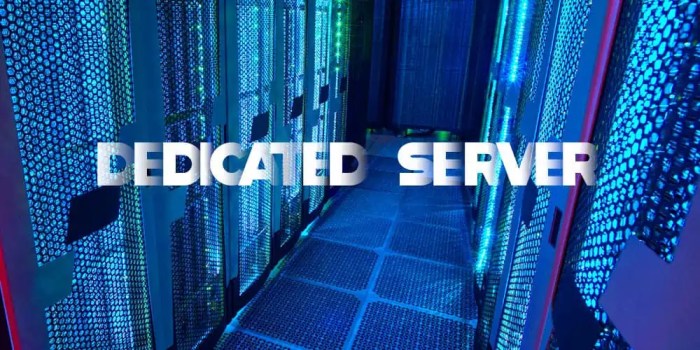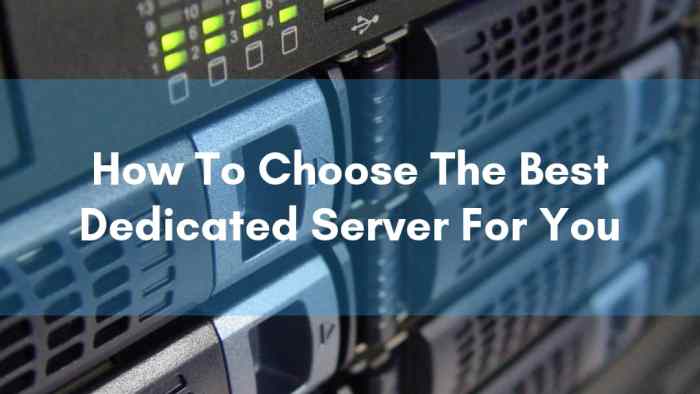In the digital age, businesses rely heavily on their online presence and infrastructure to succeed. Choosing the right dedicated server is crucial for ensuring optimal performance, reliability, and security. This guide will provide you with a comprehensive understanding of the factors to consider, types of dedicated servers available, and the steps involved in selecting the right provider and setting up your server.
With the growing demand for cloud computing, dedicated servers remain an essential solution for businesses that require dedicated resources, high levels of control, and customization. Understanding your business needs and carefully evaluating the available options will empower you to make an informed decision and choose a dedicated server that aligns with your specific requirements.
Factors to Consider When Choosing a Dedicated Server
Understanding your business needs is paramount when choosing a dedicated server. Consider the type of applications you’ll be running, the expected traffic volume, and any specific software requirements.
Key Factors to Consider
Several key factors impact server selection:
-*Processing Power
Measured in GHz or cores, this determines the server’s ability to handle complex tasks and multiple users.
-*Memory (RAM)
Measured in GB, this stores data and programs temporarily, allowing for faster access and improved performance.
-*Storage
Measured in GB or TB, this determines the amount of data the server can store. Choose a storage type (HDD, SSD, NVMe) based on speed and capacity needs.
-*Bandwidth
Measured in Mbps, this determines the maximum data transfer rate between the server and the internet. Higher bandwidth is essential for handling high traffic volumes.
Budget Considerations
Budget plays a crucial role in server selection.
Determine your budget and compare the costs of different server options, including hardware, software, and maintenance. Consider the long-term costs of scaling and upgrades to ensure your server meets your evolving needs.
Types of Dedicated Servers

Dedicated servers come in various types, each with its unique features and suitability for different business requirements. Understanding these types is crucial for selecting the best option that aligns with your specific needs.
Managed Dedicated Servers
Managed dedicated servers offer a comprehensive service where the hosting provider takes care of all technical aspects of server management. This includes hardware maintenance, software updates, security monitoring, and performance optimization. Advantages:
- No technical expertise required
- Minimal maintenance effort
- Enhanced security and reliability
Disadvantages:
- Higher cost compared to unmanaged servers
- Limited customization options
Unmanaged Dedicated Servers
Unmanaged dedicated servers provide you with complete control over your server’s management and configuration. You are responsible for all technical aspects, including hardware maintenance, software installation, and security measures. Advantages:
- Lower cost than managed servers
- Full customization and control
- Suitable for businesses with in-house technical expertise
Disadvantages:
- Requires technical expertise for management
- Time-consuming maintenance tasks
- Security risks if not managed properly
Colocation Servers
Colocation servers are dedicated servers that are housed in a data center facility. You own and manage the server, while the data center provider provides the physical space, power, cooling, and network connectivity. Advantages:
- Physical security and redundancy
- Scalability and flexibility
- Access to high-speed network infrastructure
Disadvantages:
- Higher cost than traditional dedicated servers
- Requires physical access to the server
- Limited customization options due to data center policies
Choosing the Right Provider
Selecting a reputable provider is paramount when choosing a dedicated server. Research and compare different providers to find one that aligns with your specific needs and requirements.
Key Criteria to Consider
When evaluating providers, consider the following key criteria:
-*Reliability
Choose a provider with a proven track record of uptime and reliability.
-*Uptime
Ensure the provider offers a high uptime guarantee, such as 99.9% or higher.
-*Customer Support
Opt for a provider with responsive and knowledgeable customer support available 24/7.
-*Reputation
Look for providers with positive reviews and testimonials from previous customers.
-*Pricing
Compare pricing plans from different providers to find the best value for your budget.
Benefits of Working with a Reputable Provider
Working with a reputable dedicated server provider offers several advantages:
-*Peace of Mind
Knowing that your server is managed by a reliable provider gives you peace of mind.
-*Improved Performance
Reputable providers typically invest in high-quality hardware and infrastructure, ensuring optimal performance for your server.
-*Enhanced Security
Reputable providers implement robust security measures to protect your data and applications from unauthorized access.
-*Expert Support
You can rely on expert support from the provider’s team of engineers and technicians.
-*Scalability
Reputable providers often offer scalable solutions that allow you to easily upgrade or downgrade your server resources as needed.
Installation and Setup

Installing and setting up a dedicated server is a crucial step in ensuring its optimal performance.
Proper configuration and security measures are essential for a secure and efficient server environment. This guide will provide a step-by-step walkthrough of the installation and setup process, highlighting important considerations for maximizing server performance.
Step 1: Operating System Installation
The first step involves installing a suitable operating system (OS) on the server. Choose an OS that aligns with your specific needs and requirements. Common options include Linux distributions (e.g., Ubuntu, CentOS) and Windows Server.
Step 2: Network Configuration
Configure the server’s network settings, including IP address, subnet mask, and gateway information. Ensure that the server is properly connected to the network and has access to the internet.
Step 3: Software Installation
Install the necessary software applications and services on the server. This may include web servers (e.g., Apache, Nginx), database management systems (e.g., MySQL, PostgreSQL), and other required software.
Step 4: Security Configuration
Implement robust security measures to protect the server from unauthorized access and malicious attacks. This includes setting up firewalls, configuring access controls, and installing antivirus and anti-malware software.
Step 5: Performance Optimization
Optimize the server’s performance by adjusting system settings, monitoring resource usage, and implementing caching mechanisms. Consider using performance monitoring tools to identify potential bottlenecks and areas for improvement.
Ongoing Maintenance and Management
Regular maintenance and management are crucial for the optimal performance and security of your dedicated server. By proactively addressing these tasks, you can prevent potential issues, improve efficiency, and ensure the longevity of your server.
Regular Tasks
- Software updates: Install security patches and software updates to address vulnerabilities and improve functionality.
- Security patches: Apply security patches to protect your server from malicious attacks and data breaches.
- Backups: Create regular backups of your data to ensure its integrity and recoverability in case of data loss.
- Hardware maintenance: Perform hardware maintenance tasks such as cleaning, replacing components, and monitoring temperatures to ensure optimal performance.
- Performance monitoring: Monitor server performance metrics such as CPU usage, memory consumption, and disk space to identify and resolve potential bottlenecks.
Managed Service Providers
Consider using a managed service provider (MSP) to handle the ongoing maintenance and management of your dedicated server. MSPs provide a range of services, including:
- 24/7 monitoring and support
- Software updates and security patches
- Data backups and disaster recovery
- Hardware maintenance and repairs
- Performance optimization and troubleshooting
Using an MSP can save you time, resources, and provide peace of mind by ensuring that your server is well-maintained and secure.
Summary

Choosing a dedicated server involves careful consideration of factors such as business needs, server types, provider reputation, and ongoing maintenance. By following the steps Artikeld in this guide, you can ensure that you select a server that meets your performance, security, and budget requirements.
Remember, a reliable and well-managed dedicated server will provide a solid foundation for your online operations, enabling you to achieve your business goals effectively.
FAQ
What is the difference between a dedicated and a shared server?
A dedicated server is exclusively dedicated to a single user or organization, providing complete control over resources, while a shared server is shared among multiple users, resulting in potentially lower costs but limited control.
How do I determine the right amount of processing power and memory for my dedicated server?
Consider the number of applications and users that will be using the server, as well as the expected traffic and data processing requirements. Consult with a provider or IT expert to determine the optimal configuration for your needs.
What security measures should I implement on my dedicated server?
Implement strong passwords, firewalls, intrusion detection systems, and regular security updates. Regularly back up your data and consider using a managed service provider for ongoing security monitoring and maintenance.


